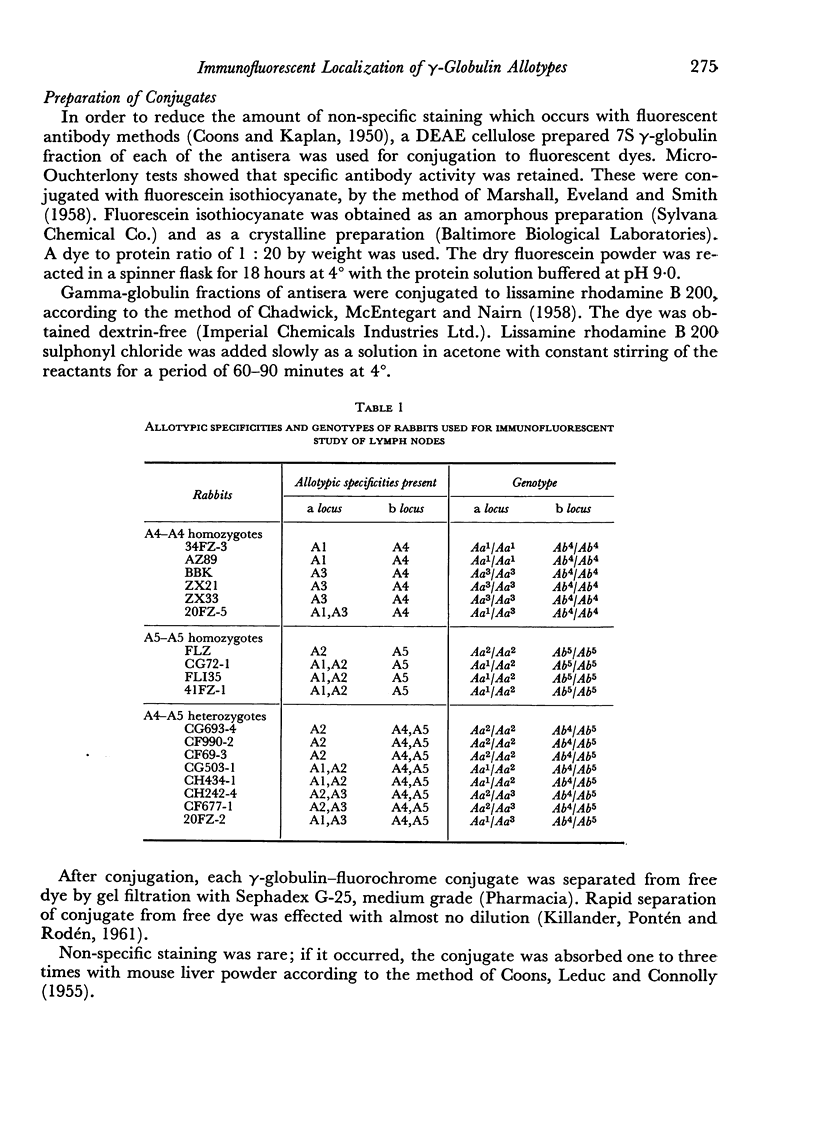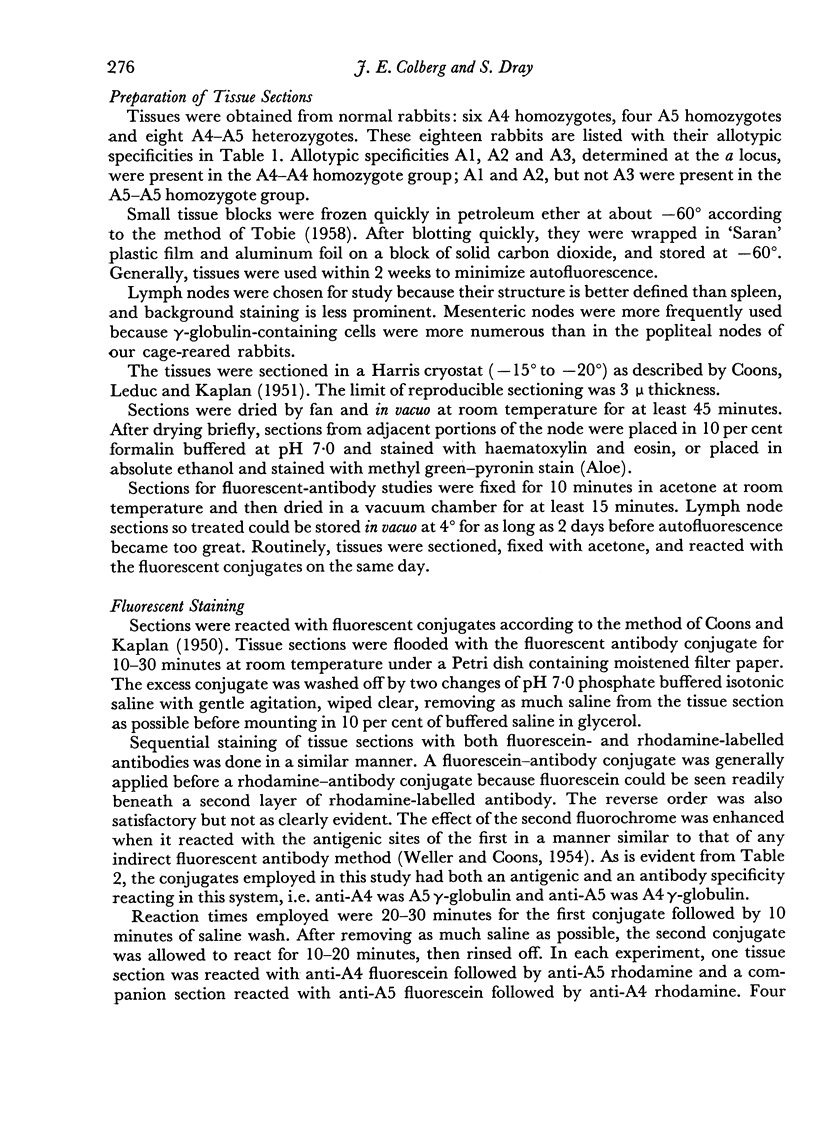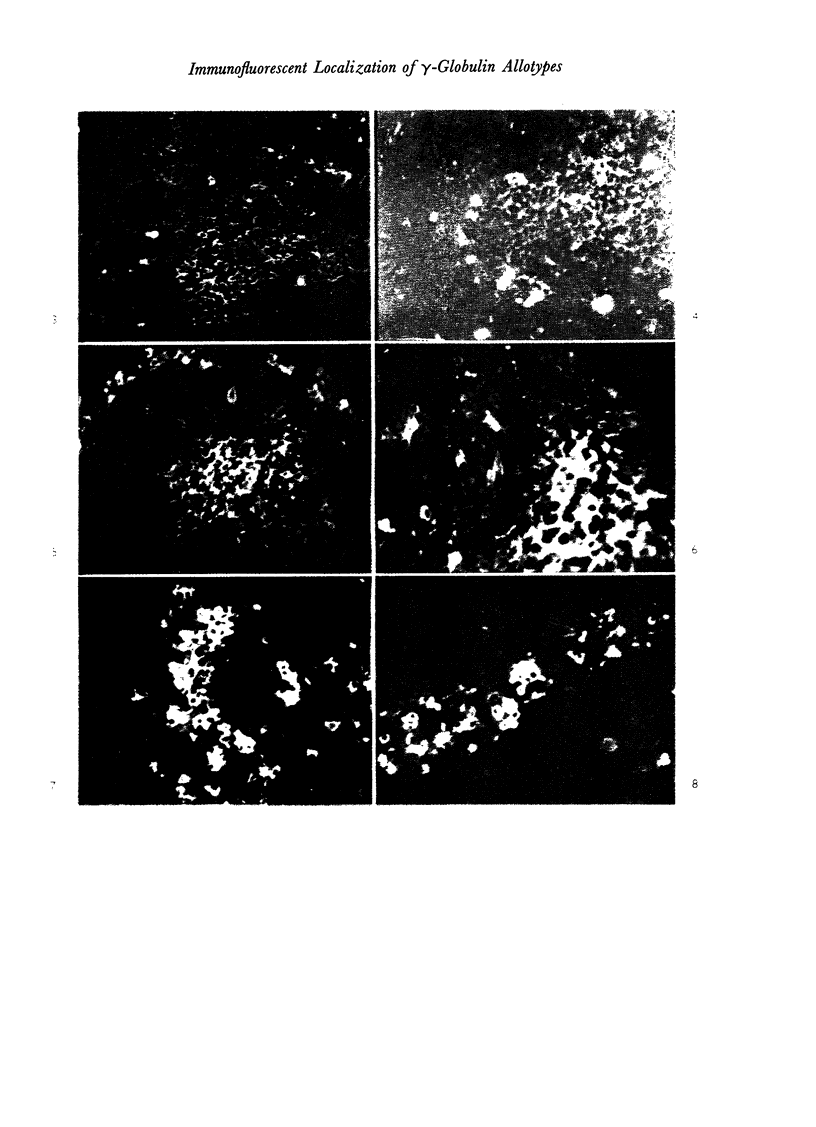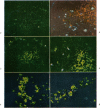Abstract
The cellular production of two rabbit γ-globulin allotypic specificities, A4 and A5, determined by allelic genes was investigated by the fluorescent antibody method. The 7S γ-globulin fractions of precipitating antisera were conjugated to fluorescein isothiocyanate and to lissamine rhodamine B sulphonyl chloride. Frozen sections of lymph nodes from eighteen rabbits, A4—A4 and A5—A5 homozygotes and A4—A5 heterozygotes, were studied after exposure to the fluorescent antibody conjugates. The conjugates, each specific for antigenic determinants of 7S γ-globulin, reacted specifically with the cytoplasm of plasma cells and intrinsic cells of the germinal centres. The rabbit anti-A4 conjugate reacted only with lymph node cells of A4—A4 and A4—A5 rabbits; the rabbit anti-A5 conjugates reacted only with cells of A5—A5 and A4—A5 rabbits; the horse anti-rabbit γ-globulin conjugates reacted with cells of all three genotypes. By a variety of techniques, identical cellular localization of the two allotypes, A4 and A5, was found in the A4—A5 heterozygotes. Less than 1 per cent of the cells in any heterozygous lymph node section contained one allotype without the other.
Full text
PDF



















Images in this article
Selected References
These references are in PubMed. This may not be the complete list of references from this article.
- CHADWICK C. S., McENTEGART M. G., NAIRN R. C. Fluorescent protein tracers; a trial of new fluorochromes and the development of an alternative to fluorescein. Immunology. 1958 Oct;1(4):315–327. [PMC free article] [PubMed] [Google Scholar]
- COONS A. H., KAPLAN M. H. Localization of antigen in tissue cells; improvements in a method for the detection of antigen by means of fluorescent antibody. J Exp Med. 1950 Jan 1;91(1):1–13. doi: 10.1084/jem.91.1.1. [DOI] [PMC free article] [PubMed] [Google Scholar]
- COONS A. H., LEDUC E. H., CONNOLLY J. M. Studies on antibody production. I. A method for the histochemical demonstration of specific antibody and its application to a study of the hyperimmune rabbit. J Exp Med. 1955 Jul 1;102(1):49–60. doi: 10.1084/jem.102.1.49. [DOI] [PMC free article] [PubMed] [Google Scholar]
- COONS A. H., LEDUC E. H., KAPLAN M. H. Localization of antigen in tissue cells. VI. The fate of injected foreign proteins in the mouse. J Exp Med. 1951 Feb;93(2):173–188. doi: 10.1084/jem.93.2.173. [DOI] [PMC free article] [PubMed] [Google Scholar]
- COONS A. H. Some reactions of lymphoid tissues to stimulation by antigens. Harvey Lect. 1957;53:113–129. [PubMed] [Google Scholar]
- DRAY S., DUBISKI S., KELUS A., LENNOX E. S., OUDIN J. A notation for allotypy. Nature. 1962 Aug 25;195:785–786. doi: 10.1038/195785a0. [DOI] [PubMed] [Google Scholar]
- DRAY S. Effect of maternal isoantibodies on the quantitative expression of two allelic genes controlling gamma-globulin allotypic specificities. Nature. 1962 Aug 18;195:677–680. doi: 10.1038/195677a0. [DOI] [PubMed] [Google Scholar]
- DRAY S., YOUNG G. O. Differences in the antigenic components of sera of individual rabbits as shown by induced isoprecipitins. J Immunol. 1958 Aug;81(2):142–149. [PubMed] [Google Scholar]
- DRAY S., YOUNG G. O., GERALD L. IMMUNOCHEMICAL IDENTIFICATION AND GENETICS OF RABBIT GAMMA-GLOBULIN ALLOTYPES. J Immunol. 1963 Sep;91:403–415. [PubMed] [Google Scholar]
- DRAY S., YOUNG G. O., NISONOFF A. DISTRIBUTION OF ALLOTYPIC SPECIFICITIES AMONG RABBIT GAMMA-GLOBULIN MOLECULES GENETICALLY DEFINED AT TWO LOCI. Nature. 1963 Jul 6;199:52–55. doi: 10.1038/199052a0. [DOI] [PubMed] [Google Scholar]
- DRAY S., YOUNG G. O. Two antigenically different gamma-globulins in domestic rabbits revealed by isoprecipitins. Science. 1959 Apr 17;129(3355):1023–1025. doi: 10.1126/science.129.3355.1023. [DOI] [PubMed] [Google Scholar]
- DUBISKI S., DUBISKA A., SKALBA D., KELUS A. Antigenic structure of rabbit gamma globulin. Immunology. 1961 Jul;4:236–243. [PMC free article] [PubMed] [Google Scholar]
- DUBISKI S., DUDZIAK Z., SKALBA D. Serum groups in rabbits. Immunology. 1959 Jan;2(1):84–92. [PMC free article] [PubMed] [Google Scholar]
- HARBOE M., OSTERLAND C. K., MANNIK M., KUNKEL H. G. Genetic characters of human gamma-globulins in myeloma proteins. J Exp Med. 1962 Nov 1;116:719–738. doi: 10.1084/jem.116.5.719. [DOI] [PMC free article] [PubMed] [Google Scholar]
- HIRAMOTO R., BERNECKY J., JURAND J. Immunochemical studies on kidney hypertrophy of the rat. Proc Soc Exp Biol Med. 1962 Dec;111:648–651. doi: 10.3181/00379727-111-27881. [DOI] [PubMed] [Google Scholar]
- ISAACSON L. C., MODLIN M., JACKSON W. P. Sodium intake and hypertension. Lancet. 1963 Apr 27;1(7287):946–946. doi: 10.1016/s0140-6736(63)91717-3. [DOI] [PubMed] [Google Scholar]
- Itano H. A., Robinson E. A. GENETIC CONTROL OF THE alpha- AND beta-CHAINS OF HEMOGLOBIN. Proc Natl Acad Sci U S A. 1960 Nov;46(11):1492–1501. doi: 10.1073/pnas.46.11.1492. [DOI] [PMC free article] [PubMed] [Google Scholar]
- KILLANDER J., PONTEN J., RODEN L. Rapid preparation of fluorescent antibodies using gel-filtration. Nature. 1961 Oct 14;192:182–183. doi: 10.1038/192182b0. [DOI] [PubMed] [Google Scholar]
- LEVY H. B., SOBER H. A. A simple chromatographic method for preparation of gamma globulin. Proc Soc Exp Biol Med. 1960 Jan;103:250–252. doi: 10.3181/00379727-103-25476. [DOI] [PubMed] [Google Scholar]
- MARSHALL J. D., EVELAND W. C., SMITH C. W. Superiority of fluorescein isothiocyanate (Riggs) for fluorescent-antibody technic with a modification of its application. Proc Soc Exp Biol Med. 1958 Aug-Sep;98(4):898–900. doi: 10.3181/00379727-98-24222. [DOI] [PubMed] [Google Scholar]
- ORTEGA L. G., MELLORS R. C. Cellular sites of formation of gamma globulin. J Exp Med. 1957 Nov 1;106(5):627–640. doi: 10.1084/jem.106.5.627. [DOI] [PMC free article] [PubMed] [Google Scholar]
- OUDIN J. Allotypy of rabbit serum proteins. I. Immuno-chemical analysis leading to the individualization of seven main allotypes. J Exp Med. 1960 Jul 1;112:107–124. doi: 10.1084/jem.112.1.107. [DOI] [PMC free article] [PubMed] [Google Scholar]
- OUDIN J. Allotypy of rabbit serum proteins. II. Relationships between various allotypes: their common antigenic specificity, their distribution in a sample population; genetic implications. J Exp Med. 1960 Jul 1;112:125–142. doi: 10.1084/jem.112.1.125. [DOI] [PMC free article] [PubMed] [Google Scholar]
- OUDIN J. L'allotypie de certains antigènes protéidiques du sérum. C R Hebd Seances Acad Sci. 1956 May 23;242(21):2606–2608. [PubMed] [Google Scholar]
- RIEDER R. F., OUDIN J. STUDIES ON THE RELATIONSHIP OF ALLOTYPIC SPECIFICITIES TO ANTIBODY SPECIFICITIES IN THE RABBIT. J Exp Med. 1963 Oct 1;118:627–633. doi: 10.1084/jem.118.4.627. [DOI] [PMC free article] [PubMed] [Google Scholar]
- TOBIE J. E. Certain technical aspects of fluorescence microscopy and the Coons fluorescent antibody technique. J Histochem Cytochem. 1958 Jul;6(4):271–277. doi: 10.1177/6.4.271. [DOI] [PubMed] [Google Scholar]
- TODD C. W. Allotypy in rabbit 19S protein. Biochem Biophys Res Commun. 1963 May 3;11:170–175. doi: 10.1016/0006-291x(63)90329-2. [DOI] [PubMed] [Google Scholar]
- VAZQUEZ J. J. Antibody- or gamma globulin--forming cells, as observed by the fluorescent antibody technic. Lab Invest. 1961 Nov-Dec;10:1110–1125. [PubMed] [Google Scholar]
- WELLER T. H., COONS A. H. Fluorescent antibody studies with agents of varicella and herpes zoster propagated in vitro. Proc Soc Exp Biol Med. 1954 Aug-Sep;86(4):789–794. doi: 10.3181/00379727-86-21235. [DOI] [PubMed] [Google Scholar]
- WHITE R. G. Antibody production by single cells. Nature. 1958 Nov 15;182(4646):1383–1384. doi: 10.1038/1821383a0. [DOI] [PubMed] [Google Scholar]
- WHITE R. G. Observations on the formation and nature of Russell bodies. Br J Exp Pathol. 1954 Aug;35(4):365–376. [PMC free article] [PubMed] [Google Scholar]





